 HOME
HOME
 LINKS
LINKS
 GLOSSARY
GLOSSARY

Last update : 26 November 2004
 HOME
HOME
 LINKS
LINKS
 GLOSSARY
GLOSSARY

 | The February 7, 1901 issue of Iron Age carried the announcement that the Hartford Hardware Company of Hartford, Connecticut was offering the Tryon wrench in six sizes. The wrench is based on U.S. patent No. 667,143 (Jan. 29, 1901). This information about the Tryon Wrench appeared on pg. 2 of the March, 1989 Missouri Valley Wrench Club Newsletter. |
 |
Frederick H. Seymour's Feb. 27, 1883 patent No. 273,170 was the basis for the ACME "twisted wire handle" and HERCULES "wire handle" wrenches manufactured in nominal sizes from 4 1/4 through 21 inches. Excerpts from hardware wholesale catalog listings for these wrenches have appeared on pg. 6 of the March 1983 and pg. 9 of the March 2000 MVWC newsletters . |
 |
| Frank Armstrong's Rapid Transit pipe wrench patent was issued Mar. 27, 1883 (Patent No. 274,544), just a month after the Seymour patent. An 1896 ARMSTRONG MFG. CO. BRIDGEPORT, CONN. ad for this wrench was reprinted on pg. 3 of the December 1985 Missouri Valley Wrench Club Newsletter. | 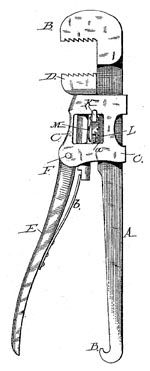 |

 |
Patent No. 956,280 was issued April 26, 1910 to George Bryar of Boston. The SHAW PROPELLOR COMPANY used the design for wrenches in nominal 4" through 15" sizes. SHAW ads have been reprinted on pg. 5 of the June 1984 and pg. 16 of the June 2001 issues of the MVWC Newsletter , and a member's SHAW collection was shown on pg. 15 of the June 2000 issue. |
|
|
Samuel Johnston's brace-wrench designs were the culmination of a half century of evolution and experiments. The 20th Century Brace Wrench based on his May 21, 1901 patent (No. 674,735) has an extra adjustment not included in the patent. Instead of two threaded holes at right angles (No. 21 &22 in the drawing), the tool has a pivot joint which is held in place by tightening the nut (No 28 in the drawing). The brace handle portion (No. 29 , 30 in the drawing) wasn't firmly attached, so most extant examples of this tool are missing this portion. 20TH CENTURY brace wrenches made with full nickel plating, rosewood, and the nut (no. 28) in brass are prized by tool collectors. |

|
Peter Gendron's June 7, 1892 patent (No. 476,629) is for a small adjustable nut wrench with an added "grip" for wheel spokes. The wrenches were made with and without the spoke grip. The wrench adjusts by turning the handle. An August 4, 1892 IRON AGE trade announcement for this wrench was reprinted on pg. 8 of the Sept. 1986 MVWC Newsletter . The distictive G in a diamond trademark and spoke grip make this a wrench a conversation piece. | ||
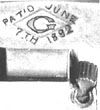 |
(left) GENDRON trademark and spoke grip detail from a close-up photo. |
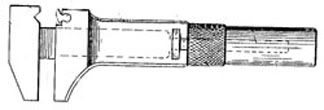 |

|
Henry Bornstein received several adjustable wrench patents. His July 26,1892 patent (No. 479,698) for a rapid adjusting nut wrench with adjustment "lock" is similar to an earlier design he patented August 26, 1890 (Pat. No. 434,912). The Missouri Valley Wrench Club Newsletter has shown information about this 1892 patent three times: March 1986, pg. 7; Sept. 1987, pg. 6; and Sept. 1989, pg. 4. One example of the wrench marked WORLDS EXPOSITION CHICAGO 1893 // PAT. JULY 26, 1892 CHICAGO ILL is shown on pg. 26 of Antique Wrenches compiled and published by Larry Finch in 1983. Two examples with variant markings are shown in picture no. 1066 in Antique & Unusual Wrenches by Alfred & Lucille Schulz (1988). The above mentioned wrenches are 5 inch long "pocket" wrenches. |
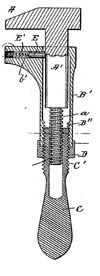 |

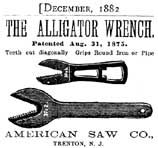 |
George Waitt received patent number 167,368 on August 31, 1875 for "IMPROVEMENT IN PIPE WRENCHES." American Saw Company claimed trade mark protection for "ALLIGATOR" in relation to this wrench design. The name stuck. The ad cut at left reprinted from an 1882 issue of BLACKSMITH AND WHEELWRIGHT appeared on pg. 6 of the Sept. 1887 MVWC Newsletter . American Saw apparently sold their wrench business to the J.A. Roebling Company (of Brooklyn Bridge fame). The Whitman and Barnes and J.H. Williams companies also manufactured the design in later years. It can be found with markings of other tool manufacturers, hardware wholesalers, and as an advertising piece for specific businesses. Judging from the large number of these wrenches still extant, Mr. Waitt's claim in his patent -- quoted below -- may have been accurate. |  |
 |
||
 | Theodore F. Vandegrift's patent number 589,765 issued Sept. 7, 1897 was the basis for numerous malleable iron adjustable wrenches made to accompany farm implements. In addition to PAT SEP 7 97 , wrenches using this design are found marked DEERING, FW, INTERNATIONAL HARVESTER, J.H.CO., McCORMICK, OSBORNE, Massey-Harris part number 123, and many other less common marks. | ||
| The design was also manufactured as the MONTE pocket wrench, and in a wood-handled version. Outline drawings of the design from farm implement parts lists have been reprinted several times in the MVWC NEWSLETTER . A 1915 R. HERSCHEL catalog listing showing the wrench in 8, 10, and 12 inch sizes was reprinted on pg. 3 of the December 1983 newsletter. The MAY 1910 HARDWARE DEALERS MAGAZINE writeup for the 5 1/2" MONTE pocket wrench (right) was reprinted on pg. 5 of the September 1991 newsletter. |  | ||

OCTOBER 2002 Daniel C. Stillson's Oct. 12, 1869 pipe wrench Patent No. 95,744 had tremendous impact. Frank Bullard's October 27, 1903 patent No. 742,389 is also significant.
| While the Stillson and Bullard pipe wrenches are historic milestones in wrench design, the INVOLUTE based on Maschil D. Converse's Oct. 30, 1900 patent No. 661,011 is equally intriguing, and probably harder to find. The design was calculated to work with round, square and hexagon shaped objects. An ad from the 1908 Sears, Roebuck & Co. catalog was reprinted on pg. 2 of the March 1986 and pg. 7 0f the September 1998 issues of the MVWC Newsletter | |
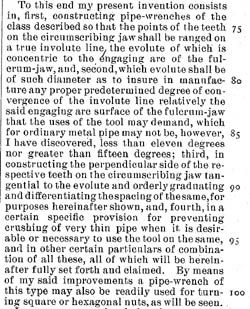 | 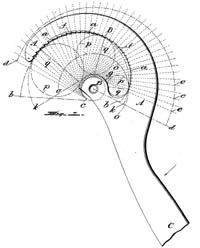 |
| This gadget that looks like an escapee from a bad science fiction movie is stamped PAT. NOV. 5, 07 in two places. | |
 | A dogged search of the patents issued that week reveals this is a buggy nut wrench, patented by Elmer F. Hayes, of Kirwin, Kansas -- (Patent No. 870,031). It works by locking the axle nut to the inside of the wheel hub, and then the wheel is turned to remove the wheel and axle nut as a unit. All this was necessary because axle grease was very thick and sticky and had to be applied with a paddle or putty knife. Wrenches of this type were intended to allow removing the axle nut without touching it and getting one's hands full of dirt and grease that even soap wouldn't remove. Appreciating the purpose and function of such a specialized tool involves learning lots of details about daily life a century ago. |
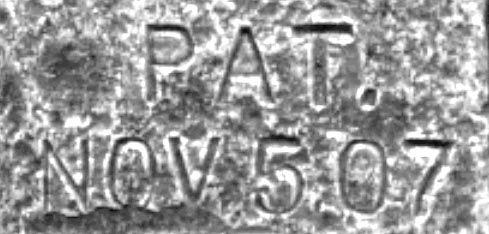 |
|
| A photo and copy of the patent drawing for this wrench appeared on pg. 10 of the December 2001 MVWC Newsletter. | |
 | The designer of this mid-19th Century classic is a fascinating character. This was William Baxter's second adjustable wrench patent. In the decade between his first patent and this one, he'd worked extensively in a number of engineering endeavors -- most of them outside the country. |
| Patent No. 84,605 was issued to William Baxter of Newark, N.J. on Dec. 1, 1868. Early models of the wrench are stamped "W. Baxter Pat Dec. 1, 1868" -- later ones have markings from E.C. Stearns & Co., W. Hawkins, and Crescent Mfg. Co. -- some later ones have no maker marks. | |
| This reprint of the illustration from an 1896 Hammacher Schlemmer ad for the wrench is reprinted from the second issue of the MVWC Newsletter which was distributed in September 1982. |
